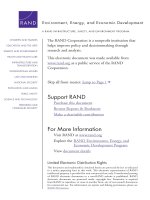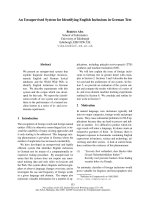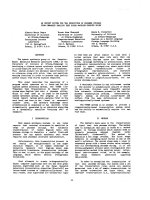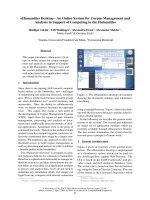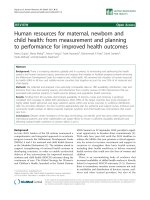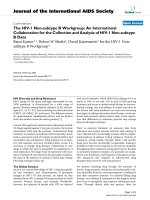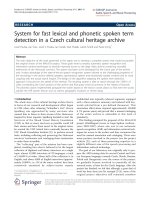An A2O-MBR system for simultaneous nitrogen and phosphorus removal from brewery wastewater
Bạn đang xem bản rút gọn của tài liệu. Xem và tải ngay bản đầy đủ của tài liệu tại đây (1.79 MB, 11 trang )
Science & Technology Development Journal – Science of The Earth & Environment, 3(1):12- 22
Research Article
An A2O-MBR system for simultaneous nitrogen and phosphorus
removal from brewery wastewater
Van Nu Thai Thien1 , Dang Viet Hung2,* , Nguyen Thi Thanh Hoa3
ABSTRACT
1
Institute for Environment and
Resources, VNU-HCM
Anaerobic/Anoxic/Oxic – Membrane BioReactor (A2 O-MBR) system was used to enhance simultaneous removal of nitrogen and phosphorus from brewery wastewater. The A2 O unit containing
microorganisms with short solids retention time (SRT) was employed mainly for removal of organic
matter and phosphorus together with denitrification. The MBR containing microorganisms with
long SRT was employed mainly for nitrification of NH4 + -N and recirculation of NO3 − -N. The model
of A2 O-MBR system made from polyacrylic with the capacity of 49.5 liters was operated with hydraulic retention times decreased from 24, 18 to 12 hours corresponding to organic loading rates
increased from 0.50, 0.75 to 1.00 kg COD/m3 .day. The results showed that the model not only
treated organic matter well but also nearly completely removed both nitrogen and phosphorus.
For all three loading rates, chemical oxygen demand (COD) concentration decreased significantly
in the anaerobic and anoxic compartments of the A2 O unit, indicating that most of organic matter
was utilized in the anaerobic and anoxic compartments for phosphorus release and denitrification,
respectively. Nitrification in the MBR was almost perfectly completed, with average NH4 + -N removal efficiencies of over 98%. Denitrification in the anoxic compartment happened as much as
possible. Demands for the development of PAOs, which were responsible for enhanced biological
phosphorus removal (EBPR) processes, could be provided. For loading rate of 0.75 kg COD/m3 .day,
treatment efficiencies of COD, NH4 + -N, total nitrogen (TN) and total phosphorus (TP) of the model
were the highest as 95.4, 99.2, 86.7 and 84.6%, respectively. Output values of these parameters
were within the limits of Vietnam National Technical Regulation on Industrial Wastewater (QCVN
40:2011/BTNMT), column A. The model of A2 O-MBR system was capable of achieving effluents with
very low nitrogen and phosphorus concentrations from brewery wastewater.
Key words: A2O-MBR system, brewery wastewater, nitrogen removal, phosphorus removal
2
Ho Chi Minh City University of
Technology, VNU-HCM
3
Ho Chi Minh City University of Natural
Resources and Environment
INTRODUCTION
By Vietnam Beer Alchohol Beverage Association,
Vietnamese people consumed nearly 4.1 billion liters
Correspondence
of beer in 2017. Currently, there are approximately
Dang Viet Hung, Ho Chi Minh City
129 brewery production facilities across the counUniversity of Technology, VNU-HCM
try with the installed capacity of 4.8 billion litres of
Email:
beer. Along with this consumption, serious probHistory
• Received: 18-01-2019
lems with environmental pollution may be caused by
• Accepted: 14-5-2019
a huge amount of brewery wastewater. This amount
• Published: 20-6-2019
of wastewater must be treated before discharge into
environment. To brewery wastewater, a combinaDOI :
/>tion anaerobic-aerobic treatment system has been
used and traditional aerobic biological treatment processes such as activated sludge (suspended growth)
or biological filter (attached growth) are often imCopyright
plemented 1–4 . However, these processes have not
© VNU-HCM Press. This is an openyet treated thoroughly nitrogen and phosphorus from
access article distributed under the
brewery wastewater to meet QCVN 40:2011/BTterms of the Creative Commons
Attribution 4.0 International license.
NMT, column A.
Anaerobic/Anoxic/Oxic (A2 O) process commonly
used in wastewater treatment is able to remove or-
ganic matter together with nitrogen and phosphorus
with its own inherent advantages such as short hydraulic retention time (HRT), high pollutant removal
efficiency and good shock loading capacity 5,6 . The
process consists of three anaerobic, anoxic, oxic compartments and one settling tank which are arranged
in sequence with nitrate circulating flow from the oxic
compartment to the anoxic compartment and sludge
circulating flow from the settling tank to the anaerobic compartment. In this process, nitrification by
nitrifiers occurs in the oxic compartment; denitrification by denitrifiers in the anoxic compartment; absorption of β -polyhydroxybutyrate (PHB) for phosphate release by Phosphorus Accumulating Organisms (PAOs) in the anaerobic compartment and then
oxidation of PHB for phosphorus accumulation in the
oxic compartment. Excess sludge discharge occurs in
the settling tank 7 .
However, A2 O process is a single sludge process with
the only line for excess sludge discharge at the settling
tank so there has been limitation to satisfy a proper
Cite this article : Thai Thien V N, Viet Hung D, Thanh Hoa N T. An A2 O-MBR system for simultaneous
nitrogen and phosphorus removal from brewery wastewater. Sci. Tech. Dev. J. - Sci. Earth Environ.;
3(1):12-22.
12
Science & Technology Development Journal – Science of The Earth & Environment, 3(1):12-22
SRT for both nitrifiers and PAOs in the oxic compartment of A2 O process 8,9 . On the other hand, nitrifiers need long SRT and PAOs need short SRT. To
solve this problem, incorporation of a biological reactor into A2 O unit, so-called A2 O – Biological Reactor
system, for simultaneous nitrogen and phosphorus
removal has been attempted in the past decade 8–10 .
The A2 O unit containing microorganisms with short
SRT is employed mainly for removal of organic matter
and phosphorus together with denitrification. The biological reactor containing microorganisms with long
SRT is employed mainly for nitrification of NH4 + -N
and recirculation of NO3 − -N.
Weitang Zhang et al. (2013) studied removal of nutrient from domestic wastewater with low COD/N ratio
by an A2 O–Biological Aerated Filter (A2 O-BAF) system. The favorable Vanoxic /Voxic was from 2.5:1 to
6:1. When Vanoxic /Voxic was 6:1, treatment efficiencies of COD, TN and PO4 3− -P achieved very high
values as 89 ± 4, 83 ± 3 and 99 ± 1%, respectively 11 .
Recently, membrane bioreactor (MBR) is an attractive
process that has been increasingly used for advanced
biological wastewater treatment. With membrane filtration replacing secondary clarification, MBR possesses a number of merits such as biomass enrichment, perfect nitrification, small footprint, ensured
sludge-effluent separation, easy manipulation of HRT
and SRT, and excellent effluent quality with little organic and solid contents 12–15 . Thus, MBR was selected as Biological Reactor in the combined system
because of the capacity to achieve enhanced nitrification rate and produce high quality effluent 16,17 .
In this study, an A2 O-MBR system was used to evaluate the effects of loading rate on the combined
system’s simultaneous nitrogen and phosphorus removal performance via continuous flow by treating
real brewery wastewater. The role of MBR in the combined system and its contribution to organic matter,
nitrogen and phosphorus removal were also investigated.
MATERIALS AND METHODS
Experimental
The polyacrylic model of A2 O-MBR system included
Anaerobic/Anoxic/Oxic unit having an approximate
dimension of 480 mm L x 150 mm W x 600 mm H
with the corresponding working volume of 36.0 liters
which was divided by baffles to create three compartments (anaerobic, anoxic, oxic) in ratio of 2:4:2 11 and
MBR having an approximate dimension of 180 mm
L x 150 mm W x 600 mm H with the corresponding working volume of 13.5 liters. Total working volume of the model was 49.5 liters. Settling tank had
13
an approximate dimension of 150 mm D x 300 mm H
with the working volume of 7.2 liters. In the MBR,
a polyethylene hollow-fiber membrane module (0.4
μm pore size, 0.32 m2 effective area, Mitsubishi Rayon
Co., Ltd, Japan) was immersed. Aeration was provided through fine air diffusers from the bottoms in
the oxic compartment and MBR while sludge in the
anaerobic and anoxic compartments was suspended
by paddle mixers at 50 rpm. Effluent was withdrawn
through the membrane module by a suction pump
that was designed for intermittent operation with a
duty cycle of 8 minutes ON / 2 minutes OFF. To mitigate membrane fouling, backflushing was carried out
every 24 hours for 15 min. Dissolved oxygen (DO)
concentrations of the oxic compartment and MBR
were determined by DO meter and controlled from 2
to 4 mg/L 18 . Return effluent ratio of 200% and return
sludge ratio of 100% were fixed 9 . Schematic representation of the experimental system was represented
in Figure 1.
1/Wastewater tank: 200 liters (PE, Vietnam);
2/Anaerobic/Anoxic/Oxic unit with three compartments: 36.0 liters (Polyacrylic, Vietnam);
3/Settling tank: 7.2 liters (Polyacrylic, Vietnam);
4/MBR with a polyethylene hollow-fiber membrane
module: 13.5 liters (Polyacrylic, Vietnam);
5/Middle tank: 50 liters (PE, Vietnam);
6/Feed pump: 11 liters/hour (Sandur, India);
7/Effluent pump: 16 liters/hour (Sandur, India);
8/Suction pump: 11 liters/hour (Blue & White, United
State);
9/Sludge pump: 11 liters/hour (Sandur, India);
10/Paddle mixer 1: (IWAKI, Japan);
11/Paddle mixer 2: (IWAKI, Japan);
12/Blower 1: 38 liters/min (RESUN, Ap 001, China);
13/Blower 2: 38 liters/min (RESUN, Ap 001, China);
14/Sludge valve 1: ∅13 (Copper, Vietnam);
15/Sludge valve 2: ∅13 (Copper, Vietnam).
System operating conditions
The wastewater treatment experiment was conducted
in four phases in the laboratory at room temperature
(∼ 25◦ C). In the short initial phase, so-called phase
0, seed sludge was given to 50% volume of the model
with MLSS concentration about 5000 mg/L. Influent
wastewater with average COD concentration of 500
mg/L diluted with tap water was pumped into the
model. Organic loading rate was increased little by
little from 0.1 to 0.3 kgCOD/m3 .day. The phase 0
ended when COD removal efficiency remained stable
at above 80%. There was no sludge discharged except
sampling to keep large amounts of biomass.
Science & Technology Development Journal – Science of The Earth & Environment, 3(1):12-22
Figure 1: Schematic representation of the experimental system.
In the next three phases according to overall treatment
performance in relation to the different loading rates,
denoted as 1, 2 and 3, respetively, raw wastewater
was pumped continuously with wastewater flow rates
increased from 49.5 to 99.0 liters/day corresponding
to HRTs decreased from 24 to 12 hours and organic,
nitrogen, phosphorus loading rates increased from
0.5 to 1.0 kgCOD/m3 .day, 0.08 to 0.16 kgTN/m3 .day,
0.014 to 0.028 kgTP/m3 .day, respectively as in Table 1.
Excess sludge was discharged from the A2 O unit and
MBR to maintain SRTs from 5 to 7 days and from 45
to 60 days, respectively.
Trans-membrane pressure (TMP) was used as an indicator of membrane fouling and monitored continuously by a data logging manometer. When TMP
reached 40 kPa, membrane washing was performed
physically and chemically following the guidelines of
the manufacturer. In the phases 0, 1, 2 and 3, the
membrane module was physically washed on a daily
basis for 15 min. During the entire period of experiment, the TMP was maintained below 40 kPa. Therefore, the membrane module was not cleaned chemically.
Wastewater source
Brewery wastewater came from the outlet of the UASB
reactor of Wastewater Treatment Plant at Nguyen Chi
Thanh – Saigon Beer Manufacturing Factory, Ho Chi
Minh City, Vietnam. The main characteristics of influent wastewater were presented in Table 1. Seed
sludge for the model of A2 O-MBR system was taken
from one of the two SBRs of this wastewater treatment
plant. Seed sludge was light brown, well-settled with
sludge volume index of 98 and MLVSS/MLSS ratio of
0.74.
Analytical methods
The samples were collected at the input and output
positions of the experimental system. They were also
collected in three compartments of the A2 O unit.
For each loading rate, the model was operated for
45 days to achieve a steady-state condition and the
samples were collected over a 3-day period during
these days. For determination of the overall treatment performance in terms of organic and nutrient
removals, the parameters of wastewater such as COD,
suspended solid (SS), Total Kjeldahl Nitrogen (TKN),
NH4 + -N, NO2 − -N, NO3 − -N and TP were analyzed
according to Vietnam National Standards together
with Standard Methods for the Examination of Water
and Wastewater (APHA, AWWA, and WEF) 19 at Research Institute for Aquaculture No.2 in Ho Chi Minh
City. The value for TN was based on the sum of TKN,
NO2 − -N and NO3 − -N. pH and DO were measured
by pH (Mettler Toledo MP220, Switzerland) and DO
(YSI 5000, United States) meters, respectively. The results below were based on average value and standard
deviation by using Microsoft Office Excel software.
RESULTS -DISCUSSION
Organic removal efficiency
COD concentrations at different positions in the
model were revealed in Figure 2 for loading rates
of 0.50, 0.75 and 1.00 kgCOD/m3 .day. The results
showed that COD concentration decreased significantly in the anaerobic and anoxic compartments.
The decline could be attributed mainly by the dilution and uptake. About 40% of COD was utilized
in the anaerobic compartment by PAOs and 40% of
COD was consumed in the anoxic compartment by
denitrifiers 10,20 . It changed slightly in the oxic compartment and the MBR. The additional organic removal was attributable to the step of membrane filtration which is beneficial to keep a higher COD removal efficiency 21,22 . Accumulation of PO4 3− -P by
PAOs happened mostly in the oxic compartment. Nitrification of NH4 + -N by nitrifiers happened mostly
in the MBR. Before wastewater flowed into the MBR,
large amount of COD in wastewater was removed. It
14
Science & Technology Development Journal – Science of The Earth & Environment, 3(1):12-22
Table 1: THE EXPERIMENTAL CONDITION IN DIFFERENT PHASES FOR THE MODEL OFA2 O-MBR SYSTEM
Phase
Duration
(day)
COD
(mg/L)
NH4 + -N
(mg/L)
TP
(mg/L)
Organic loading
(kgCOD/m3 .day)
HRT
(h)
1
1 - 45
523 ± 48
67 ± 9
13 ± 3
0.50
24
2
46 – 90
505 ± 43
70 ± 10
15 ± 3
0.75
18
3
91 - 135
518 ± 47
69 ± 10
14 ± 3
1.00
12
Figure 2: Change of COD concentration at various loading rates.
Figure 3: COD removal efficiencies at various loading rates.
15
Science & Technology Development Journal – Science of The Earth & Environment, 3(1):12-22
was considered to be advantageous for the nitrification because of non-inhibitory effects. Therefore, the
growth of nitrifiers was favourable and the nitrification was enhanced as well. COD removal efficiencies at various loading rates of the model were represented in Figure 3. For loading rates of 0.50, 0.75
and 1.00 kg COD/m3 .day, average COD removal efficiencies of the model were 94.1, 95.4 and 92.3%, respectively. It could be seen that COD removal efficiency reached the highest value at the proper loading rate of 0.75 kgCOD/m3 .day. For these three loading rates, output values of COD were within the limits of QCVN 40:2011/BTNMT, column A. COD removal at different loading rates depended on nitrogen
and phosphorus removal mutually through treatment
performance.
Nitrogen removal efficiency
Nitrogen concentrations at different positions in
the model were revealed in Figures 4 and 5 and
Figure 6 for loading rates of 0.50, 0.75 and 1.00
kgCOD/m3 .day, respectively. The results showed that
NH4 + -N and TN concentrations decreased significantly in the anaerobic and anoxic compartments.
The decline could be attributed mainly by the dilution
of the return sludge flow in the anaerobic compartment and denitrification by denitrifiers in the anoxic
compartment. It also showed that TN at the oxic compartment and MBR was mostly NH4 + -N and NO3 −
-N, respectively. Due to membrane separation, a sufficiently long SRT necessary to prevent the washout
of nitrifiers was applied in the MBR to improve the
nitrification capability of activated sludge 12 . Small
amount of NH4 + -N was metabolized for the growth
of microorganisms in the system and the remaining
was almost completely transformed by the nitrification in the MBR. Very low NO3 − -N concentration
in the anoxic compartment indicated that the denitrification happened as much as possible in this compartment 9 . It was fully reasonable with the change
of COD stated above. Removal efficiencies of nitrogen at various loading rates of the model were represented in Figure 7. For loading rates of 0.50, 0.75, 1.00
kgCOD/m3 .day, average NH4 + -N and TN removal
efficiencies of the model were 99.1 and 83.7, 99.2 and
86.7, 98.7 and 82.5%, respectively. Nitrogen removal
efficiency also reached the highest values at the proper
loading rate of 0.75 kg COD/m3 .day. For all three
loading rates, output values of NH4 + -N and TN were
within the limits of QCVN 40:2011/BTNMT, column
A. COD and nitrogen removal decreased when loading rate increased.
Phosphorus removal efficiency
Phosphorus concentrations at different positions in
the model were revealed in Figure 8 for loading
rates of 0.50, 0.75 and 1.00 kgCOD/m3 .day. The results showed that TP concentration increased to the
maximum level in the anaerobic compartment when
PAOs released phosphate by utilizing 40% of COD
in wastewater as mentioned above. Conditions that
favor the growth of PAOs and anaerobic phosphorus release could be provided. TP concentration decreased in the anoxic compartment by the dilution of
the return effluent flow from the MBR. In addition,
TP concentration also decreased significantly in the
anoxic compartment due to its uptake by Denitrifying Phosphorus Accumulating Organisms (DPAOs),
which could use nitrate and/or nitrite rather than
oxygen as an electron accepter when exposed to an
anoxic environment. In the oxic compartment, TP
was further accumulated by PAOs to reach complete
biological phosphorus removal. Yongzhi Chen et al.,
2011 also showed that DPAOs played an important
role in removing almost entirely phosphorus from
wastewater when treating domestic wastewater by an
A2 O-BAF system 9 . Phosphorus removal efficiencies at various loading rates of the model were represented in Figure 9. For loading rates of 0.50, 0.75 and
1.00 kgCOD/m3 .day, average TP removal efficiencies of the model were 74.6, 84.6 and 73.5%, respectively. Phosphorus removal efficiency also reached
the highest values at the proper loading rate of 0.75
kgCOD/m3 .day. For all three loading rates, output values of TP were within the limits of QCVN
40:2011/BTNMT, column A. In relation to the results
obtained above, the more COD removal or cell growth
is, the more phosphorus removal is.
Membrane fouling
Membrane fouling in MBR was inevitable. The TMP
in the MBR of the model was monitored continuously
to evaluate the membrane fouling during the entire
running period. The TMP was in the range of 10 – 33
kPa and the flux was from 6.4 to 12.8 L/m2 .h (LMH).
The membrane fouling rate in the MBR correlates well
with the MLSS concentration 23 . Figure 10 and Figure 11 show the variations of TMP and MLSS concentration during 135 days of operation. The MLSS concentration initially increased from around 5600 mg/L
to nearly 6000 mg/L on day 60 and was maintained for
the remaining days of running. When the flux was 6.4
LMH in the phase 1, the TMP was in the range of 10
– 16 kPa for 45 days. During the phase 2, the flux was
kept at 9.6 LMH. The TMP increased gradually with
16
Science & Technology Development Journal – Science of The Earth & Environment, 3(1):12-22
Figure 4: Conversion of nitrogen concentration for a loading rate of 0.50 kgCOD/m3 .day.
Figure 5: Conversion of nitrogen concentration for a loading rate of 0.75 kgCOD/m3 .day.
time to 26 kPa on day 90. After the phase 2, the flux
increased again to 12.8 LMH in the phase 3. The TMP
increased almost linearly and reached about 33 kPa on
day 135. As mentioned above, the membrane fouling
could be alleviated to a certain degree by the intermittent operation of the membrane (2 min rest in every
10 min operation), air bubbling and backflushing.
ment efficiencies of COD, NH4 + -N, TN, TP of the
model were the highest as 95.4, 99.2, 86.7, 84.6%, respectively. Output values of these parameters were
within the limits of QCVN 40:2011/BTNMT, column
A. Making a short SRT for A2 O unit and a long SRT
for MBR helps A2 O-MBR system remove simultaneously nitrogen and phosphorus from wastewater.
CONCLUSIONS
LIST OF ABBREVIATIONS
In this study, the model of A2 O-MBR system was operated well and treatment efficiencies of nitrogen and
phosphorus at three loading rates were high. It was
capable of achieving effluents with low nitrogen and
phosphorus concentrations from brewery wastewater. For a loading rate of 0.75 kg COD/m3 .day, treat-
A2 O-MBR: Anaerobic/Anoxic/Oxic – Membrane
BioReactor
SRT: Solids Retention Time
COD: Chemical Oxygen Demand
EBPR: Enhanced Biological Phosphorus Removal
TN: Total Nitrogen
17
Science & Technology Development Journal – Science of The Earth & Environment, 3(1):12-22
Figure 6: Conversion of nitrogen concentration for a loading rate of 1.00 kgCOD/m3 .day.
Figure 7: Nitrogen removal efficiencies at various loading rates.
TP: Total Phosphorus
QCVN 40:2011/BTNMT: Vietnam National Technical Regulation on Industrial Wastewater
HRT: Hydraulic Retention Time
PHB: β -polyhydroxybutyrate
PAOs: Phosphorus Accumulating Organisms
A2 O-BAF: A2 O-Biological Aerated Filter
DO: Dissolved Oxygen
TMP: Trans-Membrane Pressure
SS: Suspended Solid
TKN: Total Kjeldahl Nitrogen
DPAOs: Denitrifying Phosphorus Accumulating Organisms
LMH: L/m2 .h
COMPETING INTERESTS
None of the authors reported any conflict interest related to this study.
AUTHORS’ CONTRIBUTIONS
Van Nu Thai Thien: writing the draft of the research
paper.
Dang Viet Hung: designing and conducting the experiments.
Nguyen Thi Thanh Hoa: sampling and analysis of
wastewater.
REFERENCES
1. Simate GS, Cluett J, Iyuke SE, Musapatika ET, Ndlovu S, Walubita LF, et al. The treatment of brewery wastewater for reuse:
18
Science & Technology Development Journal – Science of The Earth & Environment, 3(1):12-22
Figure 8: Conversion of TP concentration at various loading rates.
Figure 9: TP removal efficiencies at various loading rates.
2.
3.
4.
5.
6.
19
State of the art. Desalination. 2011;273(2-3):235–247. Available from: 10.1016/j.desal.2011.02.035.
Annie Hill. Brewing Microbiology: Managing Microbes, Ensuring Quality and Valorising Waste. Woodhead Publishing;
2015. p. 425–456. 1st edition. Available from: 10.1016/C20140-03102-4.
Bakare BF, Shabangu K, Chetty M. Brewery wastewater
treatment using laboratory scale aerobic sequencing batch
reactor. South African Journal of Chemical Engineering.
2017;24:128–134. Available from: 10.1016/j.sajce.2017.08.001.
Wang SG, Liu XW, Gong WX, Gao BY, Zhang DH, Yu HQ. Aerobic granulation with brewery wastewater in a sequencing
batch reactor. Bioresource Technology. 2007;98(11):2142–
2147. Available from: 10.1016/j.biortech.2006.08.018.
Ma Y, Peng Y, Wang X. Improving nutrient removal of the AAO
process by an influent bypass flow by denitrifying phosphorus removal. Desalination. 2009;246(1-3):534–544. Available
from: 10.1016/j.desal.2008.04.061.
Ge S, Zhu Y, Lu C, Wang S, Peng Y. Full-scale demonstration of step feed concept for improving an anaero-
7.
8.
9.
10.
bic/anoxic/aerobic nutrient removal process. Bioresource
Technology. 2012;120:305–313. Available from: 10.1016/j.
biortech.2012.06.030.
Peng YZ, Wang XL, Li BK. Anoxic biological phosphorus uptake
and the effect of excessive aeration on biological phosphorus
removal in the A2O process. Desalination. 2006;189:155–164.
Available from: 10.1016/j.desal.2005.06.023.
Wang J, Peng Y, Chen Y. Advanced nitrogen and phosphorus
removal in A2O – BAF system treating low carbon to nitrogen
ratio domestic wastewater. rontiers of Environmental Science
and Engineering in China. 2011;5:474–480. Available from: 10.
1007/s11783-011-0360-0.
Chen Y, Peng C, Wang J, Ye L, Zhang L, Peng Y. Effects of nitrate
recycling ratio on simultaneous biological nutrient removal
in a novel anaerobic/anoxic/oxic (A2/O) – biological aerated
filter (BAF) system. Bioresource Technology. 2011;102:5722–
5727. Available from: 10.1016/j.biortech.2011.02.114.
Chen Y, Li B, Ye L, Peng Y. The combined effects of COD/N
ratio and nitrate recycling ratio on nitrogen and phosphorus removal in anaerobic/anoxic/aerobic (A2/O) – biologi-
Science & Technology Development Journal – Science of The Earth & Environment, 3(1):12-22
Figure 10: Variation of MLSS concentration during the operational period.
Figure 11: Variation of TMP during the operational period.
11.
12.
13.
14.
cal aerated filter (BAF) systems. Biochemical Engineering.
2015;93:235–242. Available from: 10.1016/j.bej.2014.10.005.
Zhang W, Peng Y, Ren N, Liu Q, Chen Y.
Improvement of nutrient removal by optimizing the volume ratio
of anoxic to aerobic zone in AAO – BAF system. Chemosphere. 2013;93(11):2859–2863. Available from: 10.1016/j.
chemosphere.2013.08.047.
Judd S, Judd C. The MBR Book: principles and applications
of membrane bioreactors in water and wastewater treatment.
Butterworth-Heinemann Publishing; 2006. p. 209–288. 2nd
edition.
Arévalo J, Ruiz LM, Parada-Albarracín JA, González-Pérez DM,
Moreno JPB, Gómez MA. Wastewater reuse after treatment
by MBR. Microfiltration or ultrafiltration?
Desalination.
2012;299:22–27. Available from: 10.1016/j.desal.2012.05.008.
Barreto CM, Garcia HA, Hooijmans CM, Herrera A, Brdjanovic
D. Assessing the performance of an MBR operated at high
biomass concentrations. International Biodeterioration &
Biodegradation. 2017;119:528–537. Available from: 10.1016/
j.ibiod.2016.10.006.
15. Meng F, Zhang S, Oh Y, Zhou Z, Shin HS, Chae SR. Hang-Sik
Shin, So-Ryong Chae. Fouling in membrane bioreactors: An
updated review. Water Research. 2017;114:151–180. Available
from: 10.1016/j.watres.2017.02.006.
16. Banu JR, Uan DK, Yeom IT. Nutrient removal in an A2OMBR reactor with sludge reduction. Bioresource Technology.
2009;100(16):3820–3824. Available from: 10.1016/j.biortech.
2008.12.054.
17. Falahti-Marvast H, Karimi-Jashni A. Performance of simultaneous organic and nutrient removal in a pilot scale anaerobic–
anoxic–oxic membrane bioreactor system treating municipal
wastewater with a high nutrient mass ratio. International
Biodeterioration & Biodegradation. 2015;104:363–370. Available from: 10.1016/j.ibiod.2015.07.001.
18. Khan SJ, Ilyas S, Javid S, Visvanathan C, Jegatheesan V. Performance of suspended and attached growth MBR systems
in treating high strength synthetic wastewater. Bioresource
Technology. 2011;102:5331–5336. Available from: 10.1016/j.
biortech.2010.09.100.
19. Clescerl LS, Greenberg AE, Eaton AD. Standard Methods for
the Examination of Water and Wastewater. APHA Publishing;
20
Science & Technology Development Journal – Science of The Earth & Environment, 3(1):12-22
1998.
20. Mateju V, Cizinska S, Krejci J, Janoch T. Biological water
denitrification. A review. Enzyme and Microbial Technology.
1992;14(3):170–183. Available from: 10.1016/0141-0229(92)
90062-S.
21. Sun XMFY, Wang XY, Li. An innovative membrane bioreactor
(MBR) system for simultaneous nitrogen and phosphorus removal. Process Biochemistry. 2013;48:1749–1756. Available
from: 10.1016/j.procbio.2013.08.009.
21
22. yun Sun F, mao Wang X, yan Li X. An innovative membrane
bioreactor (MBR) system for simultaneous nitrogen and phosphorus removal. Bioresource Technology. 2009;100:1048–
1054. Available from: 10.1016/j.biortech.2008.07.045.
23. Meng F, Chae SR, Drews A, Kraume M, Shin HS. Fenglin Yang.
Recent advances in membrane bioreactors (MBRs): Membrane fouling and membrane material. Water Research.
2009;43(6):1489–1512. Available from: 10.1016/j.watres.2008.
12.044.
Tạp chí Phát triển Khoa học và Công nghệ – Khoa học Trái Đất và Môi trường, 3(1):12-22
Bài Nghiên cứu
Nghiên cứu hệ thống A2O-MBR để loại bỏ đồng thời thành phần
nitơ và phốt pho có trong nước thải sản xuất bia
Văn Nữ Thái Thiên1 , Đặng Viết Hùng2,* , Nguyễn Thị Thanh Hoa3
TÓM TẮT
Hệ thống xử lý nước thải sử dụng phương pháp sinh học kị khí, thiếu khí, hiếu khí đồng thời và kết
hợp màng siêu lọc (A2 O-MBR) đã được sử dụng nhằm tăng cường khả năng xử lý cùng lúc thành
phần nitơ và phốt pho có trong nước thải sản xuất bia. Cụm A2 O chứa vi sinh vật với thời gian lưu
bùn ngắn chịu trách nhiệm loại bỏ hữu cơ, phốt pho và khử nitrat. Bể MBR chứa vi sinh vật với thời
gian lưu bùn dài chịu trách nhiệm nitrat hóa amoni và tuần hoàn nitrat. Mô hình A2 O-MBR được
làm bằng mica với thể tích chứa 49,5 lít đã được vận hành với thời gian lưu nước giảm dần từ 24, 18
đến 12 giờ tương ứng với tải trọng hữu cơ tăng dần từ 0,50; 0,75 đến 1,00kgCOD/m3 .ngày. Kết quả
cho thấy mô hình không chỉ xử lý tốt thành phần hữu cơ mà còn loại bỏ gần như hoàn toàn nitơ và
phốt pho. Ở cả 03 tải trọng, nồng độ COD đã giảm đáng kể ở các ngăn kị khí và thiếu khí của cụm
A2 O, cho thấy phần lớn cơ chất đã được sử dụng ở các ngăn kị khí và thiếu khí, tương ứng với các
quá trình tách phốt pho và khử nitrat. Nitrat hóa trong bể MBR đã xảy ra gần như hoàn toàn, với
hiệu quả loại bỏ amoni là trên 98%. Khử nitrat trong ngăn thiếu khí được thực hiện nhiều nhất có
thể. Các điều kiện cần thiết cho sự phát triển của vi sinh vật tích lũy phốt pho (PAOs) để loại bỏ phốt
pho bởi tăng cường sinh học (EBPR) có thể đã được cung cấp. Ở tải trọng 0,75kgCOD/m3 .ngày, hiệu
quả xử lý COD, NH4 + -N, TN và TP của mô hình là cao nhất, tương ứng với 95,4; 99,2; 86,7 và 84,6%.
Giá trị đầu ra của các thông số này là nằm trong giới hạn cho phép của QCVN 40:2011/BTNMT, cột
A. Mô hình A2 O-MBR có khả năng đạt được đầu ra của nước thải sản xuất bia với nồng độ nitơ và
phốt pho rất thấp.
Từ khoá: Hệ thống A2O-MBR, nước thải sản xuất bia, loại bỏ nitơ, loại bỏ phốt pho
1
Viện Môi trường và Tài nguyên, Đại
học Quốc gia TP.HCM
2
Trường Đại học Bách khoa, Đại học
Quốc gia TP.HCM
3
Trường Đại học Tài nguyên và Môi
trường TP.HCM
Liên hệ
Đặng Viết Hùng, Trường Đại học Bách khoa,
Đại học Quốc gia TP.HCM
Email:
Lịch sử
• Ngày nhận: 18-1-2019
• Ngày chấp nhận: 14-5-2019
• Ngày đăng: 20-6-2019
DOI :
/>
Bản quyền
© ĐHQG Tp.HCM. Đây là bài báo công bố
mở được phát hành theo các điều khoản của
the Creative Commons Attribution 4.0
International license.
Trích dẫn bài báo này: Thiên V N T, Hùng D V, Hoa N T T. Nghiên cứu hệ thống A2 O-MBR để loại bỏ
đồng thời thành phần nitơ và phốt pho có trong nước thải sản xuất bia . Sci. Tech. Dev. J. - Sci. Earth
Environ.; 3(1):12-22.
22


